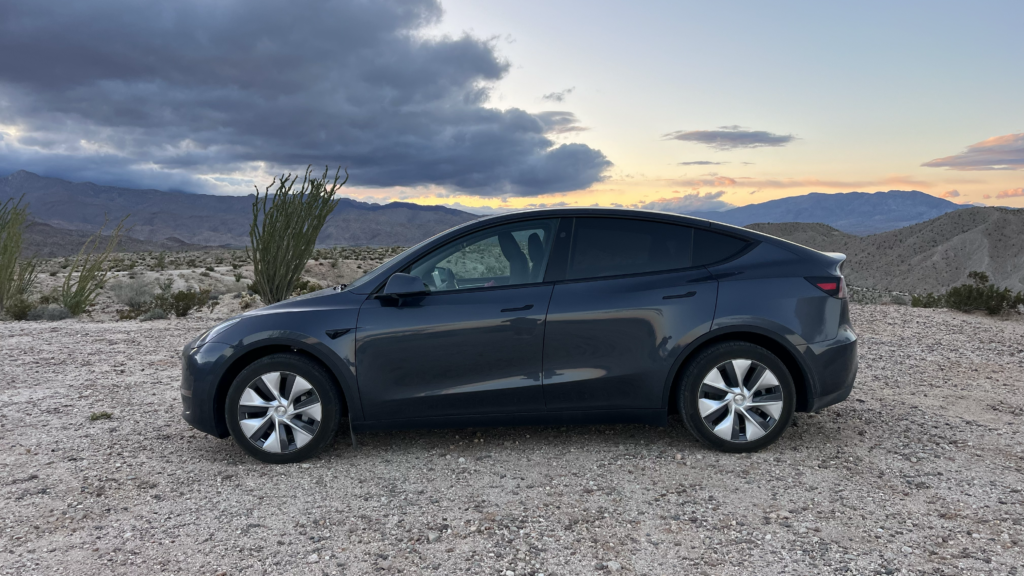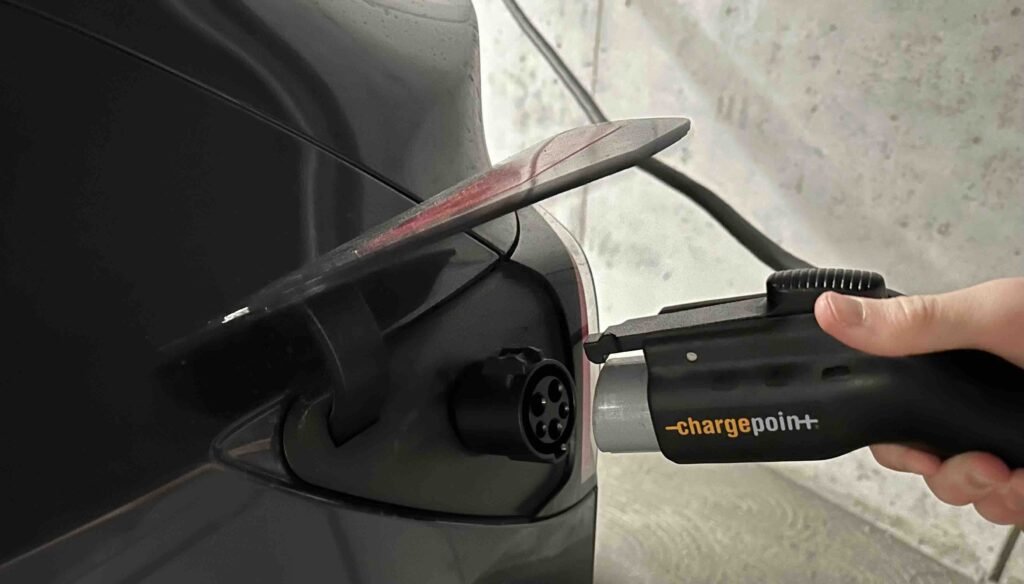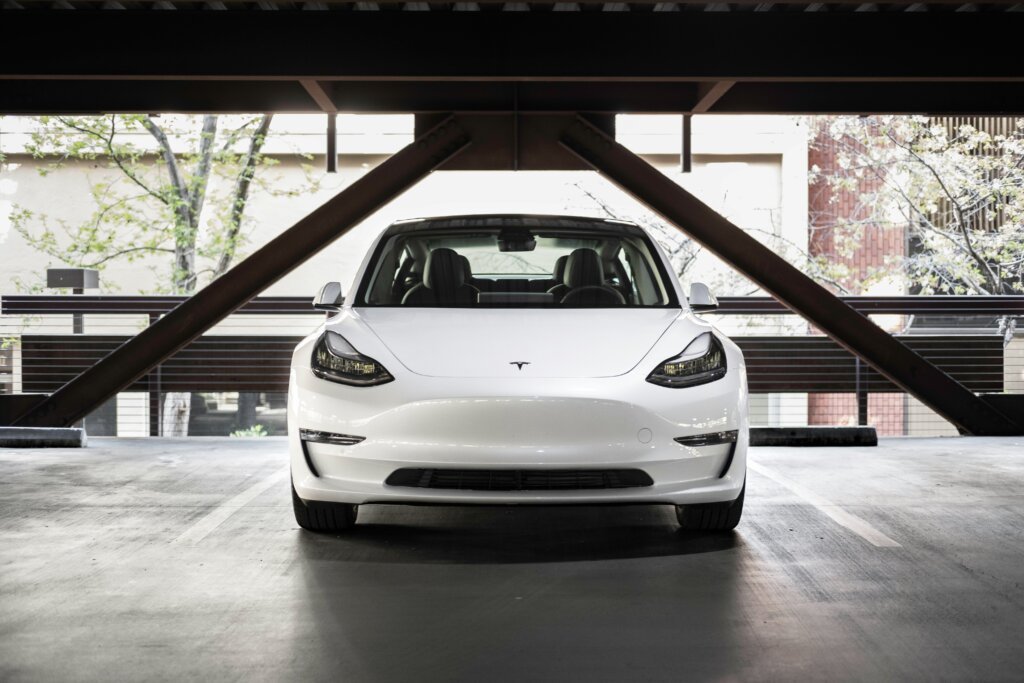This article describes everything you need to know and own to ensure you have the optimal at-home electric car charging setup. This includes charger types, and the various outlets and adapters necessary.

The most common questions shoppers have when considering buying a Tesla are “How do you charge an electric vehicle (EV)?” and “What do I need to buy to charge my EV?”. This question applies to all types of electric cars, not just Teslas.
All new EV owners must1 purchase a car charger2 because they are not included with the initial car purchase. You may not realize that you do not have a car charger until your new car is actually in the garage and unable to charge. Or you may have no idea how to even go about charging your car. Perhaps you have a pre-existing basic outlet, but it is slow and very inefficient, or maybe you want the best charger installed in your garage that money can buy.
Various charging solutions exist, ranging in cost from budget-friendly to expensive. This post will tell you everything you need to have and need to know to have the optimal at-home electric car charging setup in the United States.
As a Tesla owner and enthusiast myself, I have spent a lot of time learning all the ins and outs of electric car charging, and I’m very excited to be able to share it with you. My goal in this article is to teach you how to optimize the way you charge your EV, so you can get on the road and keep your travel adventures going! This ultimate guide is applicable to all EVs.
✈️ My Travel Essentials – What I Actually Use & Recommend! 🌍
I’ve traveled extensively and use these tools on every trip. They’ve saved me money, time, and headaches, and they’ll do the same for you! 👉 Book smarter & save more 🚀
✅ 🏨 Best Hotel Deals → Expedia
I book all my hotels through Expedia because they offer cash-back rewards and some of the lowest rates online. Tip: activate Rakuten for extra cashback and $30 free.
✅ 🎟️ Skip-the-Line Tours & Unique Experiences → Get Your Guide
Want to avoid lines and overpriced tourist traps? I use Get Your Guide to book skip-the-line passes, tours, and hidden gem activities. Use my link for 10% off your first booking!
✅ 📱 Stay Connected Without Roaming Fees → Airalo
No more SIM card hassle! I use Airalo’s cheap, reliable eSIMs to stay connected instantly in over 200 countries. Use my promo code AIRALOESIM10 for 10% off!
Short on time? Here’s the main takeaway:
I highly recommend the following as the optimal at-home electric car charging setup:
- Car charger: Use a mobile connector.
- Adapter: Use either a 6-15 or 6-20 adapter.
- Outlet: Use either a 6-15 or 6-20 outlet.
Table of Contents
Consumer Grouping
Most new EV owners end up in one of two distinct camps:
- Using a basic common household outlet—resulting in charging with poor efficiency.
- Overspending on a large charging setup—resulting in having to upgrade the entire household electric service.
Tesla, along with other EV manufacturers, lump their customers into one of these two groups. It’s a clever strategy for them, as it neatly categorizes users into two major concerns:
- Those who worry about cost.
- Those who worry about charging time.
For those on a tight budget, they want you to believe that you do not need to make any changes to your home and can avoid extra expenses. Meanwhile, for those concerned about charging time, they simply pitch their fastest way to charge your car without considering cost or limitations.
The secret to the best way to charge is that most people should not worry about charging time at all.
What Do You Need to Charge An Electric Car?
There are three things you need to charge your electric car:
- Car charger: this is the cord that plugs into your vehicle.
- Adapter: this is the piece that connects the car charger to your home infrastructure.
- Outlet: this is your home infrastructure that accepts the adapter.
Keep reading to learn the best option for each.
Electric Car Charger Types

EV chargers are what plug into an adapter/outlet and provide power to your car. There are two main charger options for charging your electric car at home:
- Hardwired charger: A hardwired charger connects directly to your electrical lines and is not easily removed. It is a permanent fixture, like a whole house air conditioner or water heater. Note: A Tesla hardwire charger is linked here; however, this charger can charge all EV brands.
- Mobile connector: A mobile connector, as its name suggests, is a mobile charger. It plugs into different adapters that correspond to common US outlets. It controls the power entering the car to not go above the electrical rate of the outlet. Note: A Tesla mobile connector is linked here; however, there are mobile connectors available for all other EV brands outside of Tesla. The Tesla mobile connector will support all EV car brands in the coming years.
The mobile connector is the best charger option for most EV drivers who want to charge their electric car at home. They are much cheaper and have the added bonus of portability. They can stay plugged in for their entire lifetime if you please, and can also be used just like the more expensive hardwired options.
Outlets For Charging Your Electric Car
There are many different outlets an electric car can connect to using a mobile connector with an adapter. Most EVs can control the amount of power pulled from the wall, limiting the charge based on the outlet rating. This article discusses the specifics of Tesla’s mobile connector, but other EVs will have comparable setups. Below is a table from Tesla’s website explaining the charging speed of each outlet.
| Outlets |
Charge Speed Miles of Range per Hour of Charge | |||
|---|---|---|---|---|
| Model 3 | Model S | Model X | Model Y | |
|
NEMA 6-50 240 volt / 50 amp breaker Maximum 32 amp output | 30 | 27 | 23 | 27 |
|
NEMA 14-50 240 volt / 50 amp breaker Maximum 32 amp output | 30 | 27 | 23 | 27 |
|
NEMA 14-30 240 volt / 30 amp breaker Maximum 24 amp output | 22 | 21 | 17 | 21 |
|
NEMA 10-30 240 volt / 30 amp breaker Maximum 24 amp output | 22 | 21 | 17 | 21 |
|
NEMA 6-20 240 volt / 20 amp breaker Maximum 16 amp output | 15 | 14 | 12 | 14 |
|
NEMA 6-15 240 volt / 15 amp breaker Maximum 12 amp output | 11 | 10 | 9 | 10 |
|
NEMA 5-20 120 volt / 20 amp breaker Maximum 16 amp output Common household outlet | 4 | 4 | 3 | 4 |
Adapters For Charging Your Electric Car
Tesla sells 8 different charging adapters, shown in the image below (each of these adapters corresponds to the outlet type in the table above). These adapters are used for different outlet types found in the US for different purposes. Two come with the mobile connector by default. The ones to the left of the lineup are slower and the ones to the right max out the mobile connectors charging speed.
The 2023 Tesla Model Y will be used as an example for comparing charging speeds. You can charge at 3 miles per hour using this slowest outlet 5-15 (Common US Receptacle). You can charge at 28 miles per hour using the fastest 14-503 adapter (Common Stove Receptacle). Although these are the adapters that come with many mobile connectors, including Tesla and Ford, I stand firm on not using these default adapters for charging your electric vehicle.

Tesla, among other third-party companies like EVSE Adapters, sells different attachments for their mobile connectors to support many different outlet types. Relying on the default charging options that come with your mobile connector might not be the best choice. If you are planning on using them, your boat is either too small or too large for your voyage.
What Equipment to Avoid
These outlet/adapter combinations are not recommended, and here is why.
Why Not Use The 5-15 Outlet/Adapter?
Most garages already have a 5-15 outlet already installed. They typically require no work to get your car charging without any electrical changes. There is no doubt this is a user-friendly option for charging your new electric car.
While this outlet may work short-term, it has many negatives:
- It is way too slow: While I want to stress charging time is very rarely an issue with electric car ownership, the 5-15 outlet’s charging speed is too slow. It is that simple. For the average daily commute of 41 miles, rounded to 50 miles to account for post-work errands, it would require a whopping 16 hours to reach a full charge. While this might suit those who are only away from home for 8 hours a day, it quickly becomes impractical for those needing more frequent charging.
- It is inefficient: The overhead of running the car’s charging system takes a lot of power, which in turn ruins your charging efficiency. While you can get around 90% efficiency when charging from a 240-volt source, a 5-15 charges at about 75% efficiency. While using a pre-existing outlet may be cheaper in the short-term, it will take more energy, which means more money to charge your car the same amount of miles. You can expect to pay 20% more for every charge—that’s about $44 more a “tank”. Money saved by not installing a dedicated charging setup will quickly be spent on the added charging cost.
- If the heat is running, the car will not get any charge: An additional drawback of the 5-15 outlet is its inability to cope with simultaneous power demands. If your electric car is running the heat, the outlet might not provide sufficient power to charge the vehicle, further limiting its practicality in colder climates or during winter months.
- Safety concerns with the outlet: The 5-15 outlet is likely an older residential outlet, not designed for the continuous high demand that EV charging requires. This raises safety concerns as older outlets may not be equipped to handle the heat generated during prolonged charging sessions, potentially posing a fire hazard.
- Shared circuit with other devices: Most likely, the 5-15 outlet is on a circuit shared with other household devices. Electric cars necessitate a dedicated circuit for charging to ensure a consistent and safe power supply. EVs use the full 1440 watts the outlet’s circuit can provide. Sharing the circuit with other devices may lead to the circuit tripping (best case scenario) or other electrical issues. If this happens in the middle of the night or while you are not home, your car has stopped charging without your knowledge. Opting for a separate circuit is crucial for the safe charging of electric vehicles.
Why Not Use The 14-50 Outlet/Adapter?
When contemplating the use of a 14-50 outlet for your EV charging needs, it’s essential to weigh the advantages and potential challenges associated with this option. When buying a car, most people typically over-purchase for what they need. Why not apply that same logic to your charging setup?
While the 14-50 outlet boasts a significantly faster charging rate, installing this outlet comes with a set of negatives that might influence your decision:
- Excessive speed for most users: The 14-50 outlet offers a charging speed that exceeds the needs of the average user. For individuals whose daily charging requirements are relatively modest, the high charging capacity is excessive. With the same 50-mile commute used in the above scenario, your car will recharge in less than 2 hours. That is way quicker than anyone would need before commuting the next day. Charging time is not an active process for the user, it is all passive time—no reason to need to decrease passive time.
- Electrical box requirements: Implementing this outlet necessitates the availability of two new slots in your electrical box. This requirement can pose challenges, especially if your current electrical box is already at capacity. Many homes in the US are limited to 100 amp service total. This may require a new electrical run to the house which can cost in the tens of thousands of dollars.
- Need for new outlet and electrical line: The installation process often involves not only a new outlet but also the running of a dedicated electrical line to support the 14-50 outlet. This involves additional costs and logistical considerations.
- Consumer-grade outlets at big box stores: It’s worth noting that the 14-50 outlets available at big box stores are typically not of industrial rating. This raises questions about their long-term durability and suitability for consistent EV charging.
- Safety concerns: The 40 amps of consistent power that the 14-50 outlet delivers should be approached with caution. While it offers rapid charging, safety becomes a paramount consideration, especially if your home’s electrical infrastructure is not well-equipped to handle such power consistently. Always consult a certified electrician.
- Availability and cost of commercial-rated outlets: Commercial-rated outlets suitable for EV charging can be challenging to find and often come with a hefty price tag due to high demand. This may impact the overall feasibility and cost-effectiveness of choosing the 14-50 outlet as your primary charging solution.
When considering the use of the 14-50 outlet, it’s crucial to weigh the benefits of fast charging against the potential challenges and costs associated with its installation.
The Golden Outlet/Adapter – The Optimal At-Home Electric Car Charging Setup
There are two standout options when it comes to EV charging: the 6-15 and 6-20 charging options. These particular outlets/adapters occupy a sweet spot, offering a harmonious balance between efficiency and cost-effectiveness. They are 240 volt outlets, capable of 12 or 155 amps of charging power, respectively. Your car will always be ready for your commute the next day and you will not have to break the bank to install them. These are the optimal at-home electric car charging setups I recommend.
- It is fast enough: Considering the average commute in the US is around 41 miles, let’s round that up to 50 to accommodate additional miles for post-work errands and to provide a margin of error. The 6-15 and 6-20 deliver 10 or 14 miles per hour of charge, respectively, enabling you to fully recharge your commute within a reasonable timeframe of 3.5 to 5 hours. For the 6-20, that is only 1.5 hours longer than the 14-50.
- No, really. It is plenty fast: This charging duration significantly exceeds the typical gap between work hours. For example, even if you arrived home with a completely depleted battery and had to leave for work at 7 am, initiating the charging process at 2 am would ensure you not only make it to work but also have ample charge to spare for the return journey.
- Possibility for reuse: What adds to the appeal of these options is the smaller gauge (size) of the wire required. Some individuals might even have the opportunity to repurpose existing wires from an old 5-15 or 5-20 outlet, provided the wires are in good condition and exclusively connected to that outlet. Upgrading the wiring to a 240-volt line—necessary for the 6-15 or 6-20—requires only minor alterations in your electrical box. Importantly, this process typically demands only one additional electric box slot, making it a relatively simple upgrade.
- Cheaper installation and components: These outlets/adapters provide a lower amount of power providing at least a marginal improvement in safety. Additionally, the smaller gauge of wire translates to more affordable costs, making it an economically attractive choice. Versions of these outlets are abundant, and both commercial and industrial-grade outlets are available at reasonably low prices, solidifying their status as cost-effective and practical charging solutions
Yes, you can do these same minor upgrades specified above for a 6-15 or 6-20 outlet to provide power to a hardwired charger. The sweet spot of these outlets is the amperage and the voltage rating, not their form.
Real-Life Comparison of Charging Speeds
I created this table to demonstrate charging speeds for the 2023 Tesla Model Y using different outlets/adapters to replenish the battery for a commute of 50 miles.
| Charging Outlet | Charging Speed (mph) | Time to recover (hr) | Latest charging start time for 7 am commute (time) |
| 5-15 | 4 | 12.5 | 6:30 PM -1 |
| 6-15 | 10 | 5 | 2:00 AM |
| 6-20 | 14 | 3.57 | 3:25 AM |
| 14-50 | 28 | 1.78 | 5:13 AM |
Frequently Asked Questions (FAQs)
1. What percentage should I charge my electric car to?
The best advice is to follow your electric car’s guidance. Most EVs will notify you if you repeatedly charge the car too high or too low.
Most commonly, EVs should be charged to 80% because they have lithium-ion batteries. This will keep the battery healthy. The battery can be charged over 80% when going on longer distance trips. However, doing this daily can cause damage to the battery over the lifespan of the vehicle.
In 2024, more and more electric cars use a special battery type called lithium iron phosphate (LFP). These cars should be charged to 100% instead of 80%. An example of this is the Tesla Model 3 Base model.
2. What adapters should I have for road trips?
The 5-15 and the 14-50 adapters are best for road trips. The matching outlets for these adapters can be found at most RV parks and most people’s homes. Don’t forget to pack your mobile connector!
3. How should I charge my EV when traveling?
The easiest way to charge your EV when traveling is to stop at a Tesla supercharger to get the fastest charging speeds. The network is very dependable because of its many locations.
4. What is the difference between an electric car charger and an EVSE?
Great question! Check out my article What Is An EVSE Charging Station? where I explain in detail the difference between an eclectic car charger and an EVSE.

Conclusion – Optimal At-Home Charging Setup For Your Electric Car
I highly recommend the following option for your EV charging setup:
- Car charger: Use a mobile connector.
- Adapter: Use either a 6-15 or 6-20 adapter.
- Outlet: Use either a 6-15 or 6-20 outlet.
If you take anything away from this article, make sure you make intelligent choices with what you need to buy to charge your car. Oversizing your charging system is not the one-size-fits-all that EV companies want you to believe. Interested in more EV content? Learn why the Tesla Model 3 Base model is the most practical commuter vehicle.
Thinking About Getting a Tesla? 🚗⚡
If you’re considering buying a Tesla, you can get up to $2,500 off your purchase by using my referral link! It is highly recommended to purchase a Tesla through a referral link—it saves you money at no extra cost. 😊
- If you are buying an EV and planning to only charge at public fast chargers, I would reconsider your options ↩︎
- Technically referred to as Electric Vehicle Supply Equipment (EVSE). The “charger” electronics are in the car itself. If you are interested in this naming quirk, please read What Is An EVSE Charging Station? Surprising Facts You Didn’t Know ↩︎
- The 6-50 outlet will also charge at this same speed but will be left out as they are typically not permitted for new construction ↩︎
- Charging a 60 kWh battery with a retail electric rate of $0.28 per KWh ↩︎
- Per the National Electric Code (NEC), a continuous circuit can only pull 80% of its rated amperage ↩︎
Disclaimer:
This blog post reflects my personal opinions on electricity and is not authored by a certified electrician or safety professional. It does not constitute professional advice. Readers should consult qualified experts for specific electrical or fire safety concerns, as I do not assume responsibility for any actions taken based on the information provided.
Last Updated:
Disclaimer: This article is intended to be for informational purposes only and may contain affiliate links. Refer to the full disclaimer for more information.



